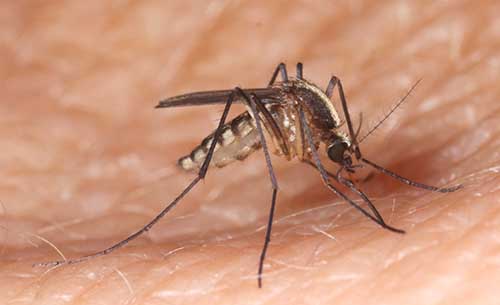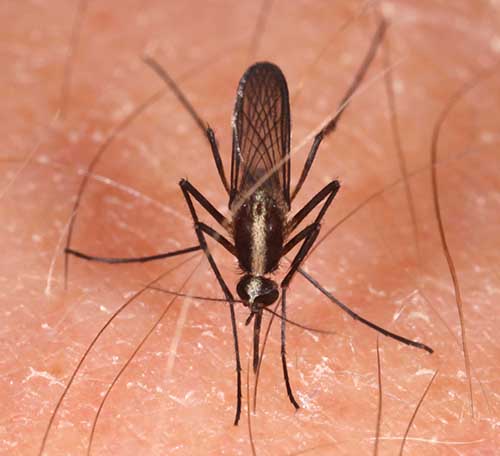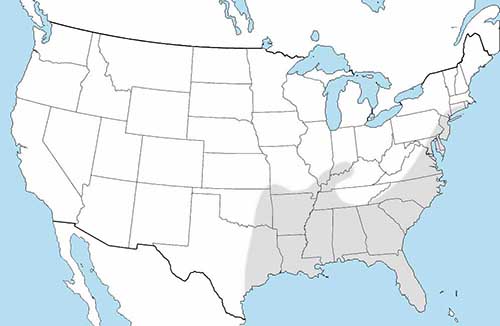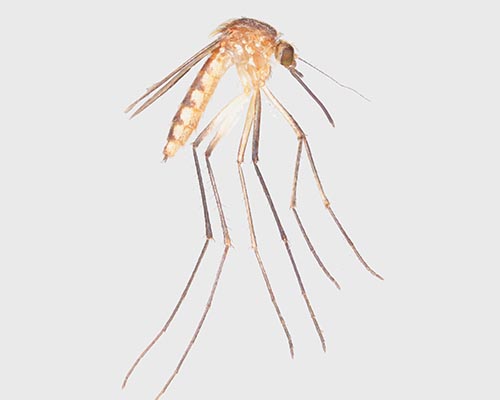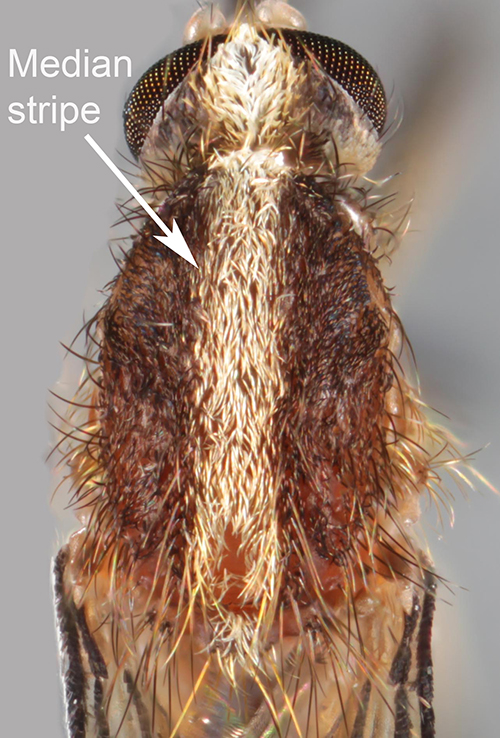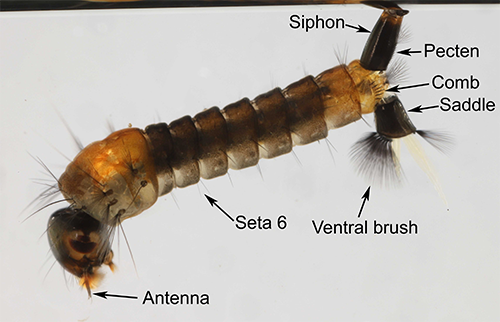common name: No common name
scientific name: Aedes atlanticus (Dyar and Knab) (Insecta: Diptera: Culicidae)
Introduction - Synonymy - Distribution - Description and Life Cycle - Medical and Veterinary Significance - Management - Selected References
Introduction (Back to Top)
Aedes atlanticus (Dyar and Knab) is a floodwater mosquito found throughout the southeastern United States that resides in woodland areas (Carpenter and LaCasse 1955, King et al. 1960, Roberts and Scanlon 1975, Burkett-Cadena 2013). It is a medium-sized mosquito species with females that are historically considered indistinguishable from Aedes tormentor (Carpenter and LaCasse 1955, King et al. 1960, Roberts 1973, and Sudia et al. 1971). Aedes atlanticus is the primary vector of Keystone virus, a subtype of California encephalitis that is rarely reported in humans (Sudia et al. 1971, Roberts 1973, LeDuc et al. 1975, Roberts and Scanlon 1975, Watts et al. 1988, Lednicky et al. 2018).
Figure 1. Adult female Aedes atlanticus (Dyar and Knab) feeding (lateral view). Photograph by N. Burkett-Cadena (nburkettcadena@ufl.edu), University of Florida.
Figure 2. Adult Aedes atlanticus (Dyar and Knab) (dorsal view). Photograph by N. Burkett-Cadena (nburkettcadena@ufl.edu), University of Florida.
Synonymy (Back to Top)
Ochlerotatus (Protoculex) atlanticus (Reinert et al. 2008)
Distribution (Back to Top)
Aedes atlanticus is found in woodland habitats across the southeastern United States, ranging west to Texas and Kansas, and reaching as far north as New York (Carpenter and LaCasse 1955, King et al. 1960, Roberts and Scanlon 1975). It is suggested that the mosquito’s western range is limited by the 100-cm precipitation line while the species northern range is restricted by the 0°C January isotherm (LeDuc et al. 1975).
Figure 3. Distribution map of Aedes atlanticus (Dyar and Knab) in the United States based upon LeDuc et al. 1975. Map by N. Burkett-Cadena (nburkettcadena@ufl.edu), University of Florida.
Description and Life Cycle (Back to Top)
Adults: Aedes atlanticus is a medium-sized mosquito with a broad white longitudinal stripe extending across the medial aspect of the scutum (Carpenter and LaCasse 1955, King et al. 1960, and Roberts 1973). The female of this species is historically difficult to distinguish from that of Aedes tormentor (Carpenter and LaCasse 1955, King et al. 1960, Roberts 1973, and Sudia et al. 1971). Although, minor differences in the pale scales on the dorsal aspect of the head of these two species have been observed (Harrison et al. 2016). Adults of Aedes atlanticus also closely resemble Aedes dupreei and Aedes pertinax, differing from these two species in size and patterns of pale scales on the scutum, hind legs and occiput of the head (King et al. 1960, Burkett-Cadena 2013, Shroyer et al. 2015).
Figure 4. Lateral aspect of Aedes atlanticus (Dyar and Knab). Photograph by N. Burkett-Cadena (nburkettcadena@ufl.edu), University of Florida.
Figure 5. Aedes atlanticus (Dyar and Knab) scutum. Photograph by N. Burkett-Cadena (nburkettcadena@ufl.edu), University of Florida.
Aedes atlanticus can be found in shaded woodland areas during the daytime and will disperse to nearby open fields during the evening and dusk to feed (Roberts 1973, Roberts and Scanlon 1975, LeDuc et al.1975). While the females are crepuscular, they will feed opportunistically on hosts that are active in the woodland areas during the day (Roberts 1973, LeDuc et al. 1975, Roberts and Scanlon 1975). Aedes atlanticus females have been described as severe day-biters in and around their woodland habitats (Michener 1947, King et al. 1960, and Roberts 1973). They feed on a variety of hosts including small mammals (Edman 1971, Roberts 1973, Roberts and Scanlon 1975, LeDuc et al. 1975, Watts et al. 1988), birds (Edman 1971) and reptiles (Crans 1968, LeDuc et al. 1975).
Eggs: Like all aedine floodwater species, Aedes atlanticus lay eggs that resist desiccation and tend to oviposit on soil or vegetation in areas prone to flooding. Aedes atlanticus females prefer to lay their eggs in depressions and roadside ditches in woodland areas, fields, and along tree lines (Roberts 1973, LeDuc et al. 1975), although shallow pools with thick vegetation have been used for oviposition (King et al. 1960). Aedes atlanticus eggs are a shiny blue-black, have a concave dorsal profile, and are large relative to other eggs of this genus (Craig and Horsfall 1960). These eggs do not diapause but exhibit a period of quiescence, which is terminated after several weeks of warm weather along with heavy rains (LeDuc et al. 1975; Diniz et al. 2017).
Larvae: Larvae of Aedes atlanticus have distinct coloration that is useful for recognition in the field. They are easily distinguished from the larvae of Aedes tormentor. The thorax and terminal abdominal segments of Aedes atlanticus are yellowish in color, giving the larva a somewhat banded appearance. Aedes atlanticus larvae have antennae that are less than half the length of the head. Their lateral abdominal setae (seta 6) on segments I and II are doubled, whereas segments III-VI have single setae. The comb on segment VIII has 4 to 6 thorn-shaped scales on a single row. The pecten has around 7 to 12 teeth that are evenly spaced along the basal aspect of the siphon. Segment X is completely encircled by the saddle and accompanied by a large ventral brush (Carpenter and LaCasse 1955, Darsie and Ward 2005, Burkett-Cadena 2013).
Figure 6. Aedes atlanticus (Dyar and Knab) larva. Photograph by N. Burkett-Cadena (nburkettcadena@ufl.edu), University of Florida.
Pupae: Aedes atlanticus pupae have distinct combinations of setae on the cephalothorax, metanotum, and abdomen which can be used to differentiate this species from other Aedes pupae. The respiratory trumpet has extensive pigmentation and possesses several small spine-like setae scattered across the distal aspect of the inner trumpet surface (Reinert 1971).
Medical and Veterinary Significance (Back to Top)
Aedes atlanticus is the primary vector for Keystone virus (genus Orthobunyavirus), a subtype of California encephalitis virus, (Sudia et al. 1971, Roberts 1973, LeDuc et al. 1975, Roberts and Scanlon 1975, Watts et al. 1988, Lednicky et al. 2018). Keystone virus has been found in ten other species of mosquitoes, with Aedes atlanticus, Aedes infirmatus, and Aedes taeniorhynchus accounting for 96 percent of virus isolations in one study (Sudia et al. 1971). Several investigations have documented the maintenance of Keystone virus through vertical transmission in Aedes atlanticus (LeDuc et al. 1975, Watts et al. 1988). Watts et al. 1988 reported that mosquitoes infected with the virus via transovarial transmission were more efficient transmitters of Keystone virus compared to mosquitoes that were infected via ingestion. The use of transovarial transmission as an overwintering mechanism has also been documented (LeDuc et al. 1975, Watts et al. 1988).
Keystone virus has several vertebrate hosts including squirrels, rats, rabbits, raccoons, and white-tailed deer (Sudia et al. 1971, Roberts 1973, LeDuc et al. 1975, Roberts and Scanlon 1975, Watts et al. 1988, Lednicky et al. 2018). Detectable viremia has been reported in cottontail rabbits, gray squirrels, raccoons, and cotton rats (Sudia et al. 1971, Roberts 1973, LeDuc et al. 1975, Watts et al. 1988). While the virus is common in mosquitoes and wild mammals, there is only one documented case of Keystone virus isolated from a human host (Lednicky et al. 2018).
Management (Back to Top)
Aedes atlanticus is considered a nuisance mosquito species in the southeastern United States. Since larvae of Aedes atlanticus develop in small rainwater pools in woodland environments, this mosquito is very difficult to control in the larval stage. As a result, adulticides are used to control biting adult females, particularly after major storms that result in woodland flooding and standing water. Such events often cause large-scale hatching of dormant eggs from floodwater mosquito species, including Aedes atlanticus. In turn, this leads to large spikes in the number of host-seeking adults within several days of the storm (Boze et al. 2020, Weaver et al. 2020).
Selected References (Back to Top)
- Boze BGV, Markowski DM, Bennet D, and Williams MG. 2020. Preparations and Activities Necessary for Aerial Mosquito Control After Hurricanes. Journal of the American Mosquito Control Association 36(2S): 90-97.
- Burkett-Cadena ND. Mosquitoes of the southeastern United States. University of Alabama Press; 2013.
- Carpenter SJ and LaCasse WJ.1955. Mosquitoes of North America (north of Mexico). Univ. California Press, Berkeley. P. 151-152.
- Craig GB and Horsfall WR. 1960. Eggs of Floodwater Mosquitoes. VII. Species of Aedes Common in the Southeastern United States (Diptera: Culicidae). Annals of the Entomological Society of America 53: 11-18.
- Crans WJ. 1968. Aedes atlanticus Dyar and Knab Feeding on Turtles. Mosquito News 28(2): 239.
- Darsie RF and Ward RA. 2005. Identification and Geographical Distribution of the Mosquitoes of North America, North of Mexico. University Press of Florida. P. 108-124.
- Diniz DFA, de Albuquerque CMR, Oliva LO, de Melo-Santos MAV, and Ayres CFJ. 2017. Diapause and quiescence: dormancy mechanisms that contribute to the geographical expansion of mosquitoes and their evolutionary success. Parasites & Vectors 10(1): 310.
- Edman JD. 1971. Host-feeding Patterns of Florida Mosquitoes. Journal of Medical Entomology 8(6): 687-695.
- Harrison BA, Byrd BD, Sither CB, and Whitt PB. 2016. Mosquitoes of the Mid-Atlantic Region: An Identification Guide. Western Carolina University, Cullowhee, NC. Mosquito and Vector-Borne Infectious Diseases Laboratory Publication 2016-01. 207 pp.
- King WV, Bradley GH, Smith CN and McDuffie WC.1960. A Handbook of Mosquitoes in the Southern United States. AGR. Handbook No. 173. USDA. 188 pp. p. 66.
- LeDuc JW, Burger JF, Eldridge BF and Russell PK. 1975. Ecology of Keystone Virus, a Transovarially Maintained Arbovirus. Annals New York Academy of Sciences 266:144-51.
- Lednicky JA, White SK, Stephenson CJ, Cherabuddi K, Loeb JC, Moussatche N, Lednicky A, Morris JG. 2018. Keystone Virus Isolated from a Florida Teenager with Rash and Subjective Fever: Another Endemic Arbovirus in the Southeastern United States? Clinical Infectious Diseases 68(1): 143-145.
- Michener CD. 1947. Mosquitoes of a Limited Area in Southern Mississippi. The American Midland Naturalist 37(2): 325-374.
- Reinert JF. 1971. Descriptions of the Pupae of Aedes (Ochlerotatus) atlanticus and Aedes (O.) tormentor (Diptera: Culicidae). Florida Entomologist 54(2): 171-178.
- Reinert JF, Harbach RE and Kitching IJ. 2008. Phylogeny and Classification of Ochlerotatus and Allied Taxa (Diptera: Culicidae: Aedini) Based on Morphological Data from All Life Stages. Zoological Journal of the Linnean Society 153(1): 29-114.
- Roberts DR. 1973. Studies on the Biologies of Mosquito Species Incriminated as Vectors of Keystone Virus in Houston, Texas. Ph.D. Dissertation. University of Texas at Houston. Houston, Texas.
- Roberts DR and Scanlon JE.1975. The Ecology and Behavior of Aedes atlanticus D. & K. and other Species with Reference to Keystone Virus in the Houston Area, Texas. Journal of Medical Entomology 12(5): 537-546.
- Shroyer DA, Harrison BA, Bintz BJ, Wilson MR, Sither CB and Byrd BD. 2015. Aedes pertinax, a newly recognized mosquito species in the United States. Journal of the American Mosquito Control Association 31(1): 97-100.
- Sudia WD, Newhouse VF, Calisher CH, and Chamberlain RW. 1971. California Group Arboviruses: Isolations from Mosquitoes in North America. Mosquito News 31(4): 576-600.
- Watts DM, Bailey CL, Roberts NT, Tammariello RF, Dalrymple JM, and Clark GC. 1988. Maintenance and Transmission of Keystone Virus by Aedes atlanticus (Diptera: Culicidae) and the Gray Squirrel in the Pocomoke Cypress Swamp, Maryland. Journal of Medical Entomology 25(8): 493-500.
- Weaver JR, Xue RD, and Gaines MK. 2020. Population Outbreaks of Mosquitoes After Hurricanes Matthew and Irma and the Control Efforts in St. Johns County, Northeastern Florida. Journal of the American Mosquito Control Association 36(2S): 28-34.
